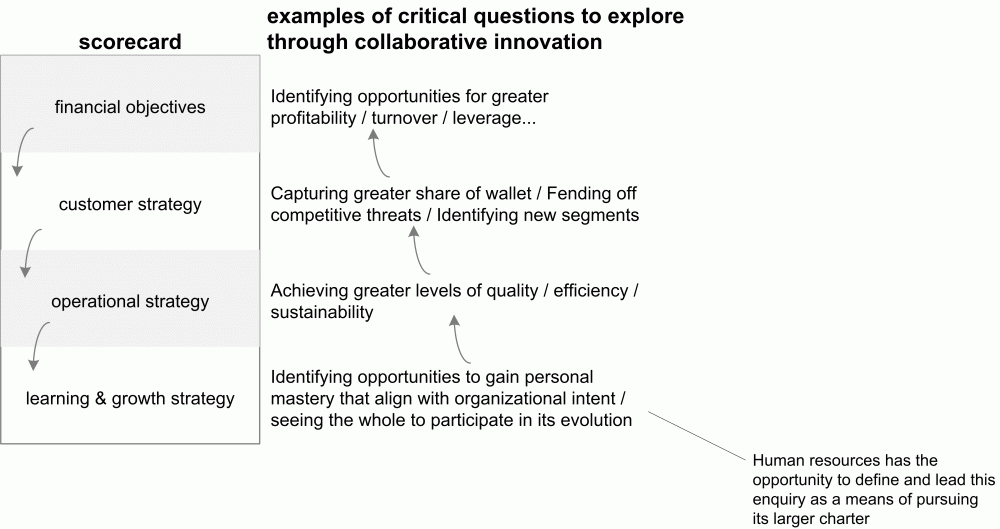By: Doug Collins
The human resources department rarely leads in applying collaborative innovation. Yet, they face daunting challenges in helping their stakeholders become a learning organization: one that can thrive in a rapidly changing world. In this article Doug Collins argues that one of the best ways that human resources can give people space to practice the five disciplines that Peter Senge identifies as defining learning organizations is to embrace the practice of collaborative innovation.
My Deepest Sympathies
My reservoir of respect overflows for the people who manage the human resources departments of large organizations.
On the one hand, the organization looks to this group to fulfill its operational charter with crisp efficiency. Hire people. Fire people. Train them in between.
On the other hand, the organization at large looks, too, to this group to help everyone realize the larger aspirational goals that people equate with an operation that can thrive in the knowledge economy. One that encourages learning and growth. One that opens space where people can contribute their ideas and insights in helping to solve critical business problems facing the organization.
The human resources department, for its part, has made more headway in fulfilling the former part of their charter than the latter. Perhaps the markings that define the path to the former appear more visible. The ever-present need to hire people, for example, leads to well-articulated, repeatable processes for recruiting the right person for the right job. The new hire appears Monday morning: a tangible result that all can see. Regulatory strictures, developed over time, codify the steps.
What of the latter part of the charter? What possibilities exist for human resources to help the people in their organization realize their leadership potential?
The need exists. Kaplan and Norton, writing in Strategy Maps, observe that “intangible assets are the ultimate source of sustainable value creation” (2003, p. 7). By “intangible assets” they mean you: the knowledge that your colleagues and you bring to the table enables the organization to accomplish that which the organization down the street struggles to imitate. A few pages later they lament that “two-thirds of organizations do not create strong alignment between their strategies and their HR and IT programs.”
For their part, the walking, talking intangible assets who choose to work for the organization increasingly expect to participate in creating the organization’s strategy map, as opposed to docilely accepting their space on the firm’s balanced scorecard like knowledge economy chattel. Opportunities for people to express and realize their aspirations for the organization continue to grow in turn, aided by the proliferation of social media and by the expectations each new generation brings with them to the labor market.
What, then, is a human resources person to do to fulfill their charter of creating an environment where the people in the organization can derive greater meaning from, and make more meaningful contributions to, their work (figure 1)?
Figure 1: the challenges and opportunities faced by human resources relative to their larger charter
Practice Clears the Path to Principle
Today, the people who practice collaborative innovation tend to be the ones that—naturally—hold the larger innovation charter within their organization: brand managers in the consumer packaged goods industry; business unit leaders in industrial firms; and, research and development leaders in the life sciences space, for example.
Yet, if we embrace the mindset of systems thinking upon which Peter Senge bases The Fifth Discipline, we can see links between the principles that define the learning organization and the practices that define collaborative innovation (figure 2).
Figure 2: the practice of collaborative innovation mapped to the principles of the learning organization
The practice of collaborative innovation can serve as a powerful means for human resources to realize its larger charter in the way that it can enable a brand manager to identify opportunities to achieve sustainable competitive advantage by engaging the community of colleagues and consumers on the promise that the idea behind the product represents to them. In the case of human resources, collaborative innovation occurs around each of the five disciplines as opposed to around the brand promise.
Moreover, if you believe that an organization’s intangible assets are the greatest source of value creation, then you can argue that human resource’s practice of collaborative innovation holds the potential for the greatest return. Please, take your seat at the table.
Waxing On, Waxing Off
Okay. Where to start? Senge covers a lot of ground.
Begin by going for the jugular. Create a space for collaborative innovation where the community can contribute their insights to the two critical questions that human resources, as the group chartered with helping the organization become a learning organization, must ask again and again and again…
What goals does the organization commit to that resonate with you?
What opportunities for personal mastery—for pursuing your career as vocation and not as a series of randomly assigned jobs within the organization—resonate with you?
The biggest obstacle that organizations face today in becoming a learning organization is overcoming the fear and ignorance that arise when the opportunity appears to ask the question about the question: essentially, “What’s important to us?” and “What’s important to me?”
The introduction of collaborative innovation, as enabled now by technology, gives the strategically minded human resources person the opportunity to engage the larger organization on the critical question through the thoughtful application of social media and foundation of virtual communities that leaven periods of person-to-person reflection.
By extension, this approach allows organizations that have embraced the balanced scorecard approach to strategy to enliven the discussion around alignment by asking the critical question of what’s worth scoring.
Many organizations have struggled to implement the balanced scorecard. They turn a simple, visual concept into a complex dashboard cum data warehouse. Organizations fumble the scorecard in part because becoming a learning organization requires the people to run the strategy map upside down. If a firm’s intangible assets represent its ultimate source of value creation, then the learning and growth perspective—Senge’s starting point—must drive the financial perspective. Anyone who has spent meaningful periods of time in large organizations instinctively knows that it determines it. The organization’s learning and growth potential determines that organization’s capacity to change (figure 3).
Figure 3: linking the scorecard with human resources’ use of collaborative innovation
Practice Makes Perfect
The people in human resources who aspire to help the people realize their potential as a learning organization can explore the possibilities of adopting collaborative innovation as their practice to realize their larger charter. The act and the discipline of framing and reframing the questions that members of the organization perceive as critical to realizing greater meaning in their work can serve as the foundation by which the organization attains the five disciplines Senge identified as present in learning organizations: system thinking, personal mastery, mental models, building shared vision, and team learning.
Years ago you developed recruitment and on-boarding practices to fulfill your obligation to hire the people the organization needs. Again, wax on and wax off: adopt and apply the practice of collaborative innovation to help the organization evolve into a learning organization. In doing so, claim your charter and take your rightful, strategic place at the table.
By Doug Collins
About the Author:
 Doug Collins serves as an innovation architect. He has served in a variety of roles in helping organizations navigate the fuzzy front end of innovation by creating forums, venues, and approaches where the group can convene to explore the critical question. He today works at Spigit, Inc., where he consults with Fortune 1000 clients on realizing their vision for achieving leadership in innovation by applying social media and ideation markets in blended virtual and in-person communities.
Doug Collins serves as an innovation architect. He has served in a variety of roles in helping organizations navigate the fuzzy front end of innovation by creating forums, venues, and approaches where the group can convene to explore the critical question. He today works at Spigit, Inc., where he consults with Fortune 1000 clients on realizing their vision for achieving leadership in innovation by applying social media and ideation markets in blended virtual and in-person communities.
Previously, Doug formed and led a variety of front end initiatives, including executive advisory programs for industry influencers, early adopter programs for lead users, corporate strategic planning, and structured explorations of new market and product opportunities. Before joining Spigit, Doug worked at Harris Corporation and at Structural Dynamics Research Corporation which is now part of Siemens Corporation.



